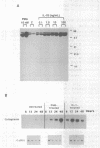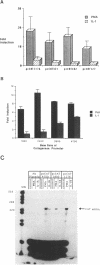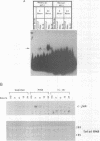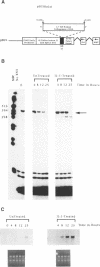Abstract
Interleukin-1 beta is believed to contribute to the pathophysiology of rheumatoid arthritis by activating collagenase gene expression. We have used a cell culture model of rabbit synovial fibroblasts to examine the molecular mechanisms of IL-1 beta-mediated collagenase gene expression. Stimulation of rabbit synovial fibroblasts with 10 ng/ml recombinant human IL-1 beta resulted in a 20-fold increase in collagenase mRNA by 12 h. Transient transfection studies using collagenase promoter-CAT constructs demonstrated that proximal sequences responded poorly to IL-1 beta, possibly due to insufficient activation of AP-1 by this cytokine. More distal sequences were required for IL-1 beta responsiveness, with a 4700 bp construct showing approximately 5-fold induction above control. To examine post-transcriptional mechanisms, transcript from a human collagenase cDNA was constitutively produced by the simian virus 40 early promoter. IL-1 beta stabilized the constitutively expressed human transcript. Furthermore, mutation of the ATTTA motifs in the 3' untranslated region of the human gene also stabilized the transcript. Finally, the rabbit collagenase 3' untranslated region destabilized a constitutively transcribed chloramphenicol acetyltransferase transcript. These data indicate that in addition to activating transcription, IL-1 beta increases collagenase transcript stability by reversing the destabilizing effects of sequences in the 3' untranslated region.
Full text
PDF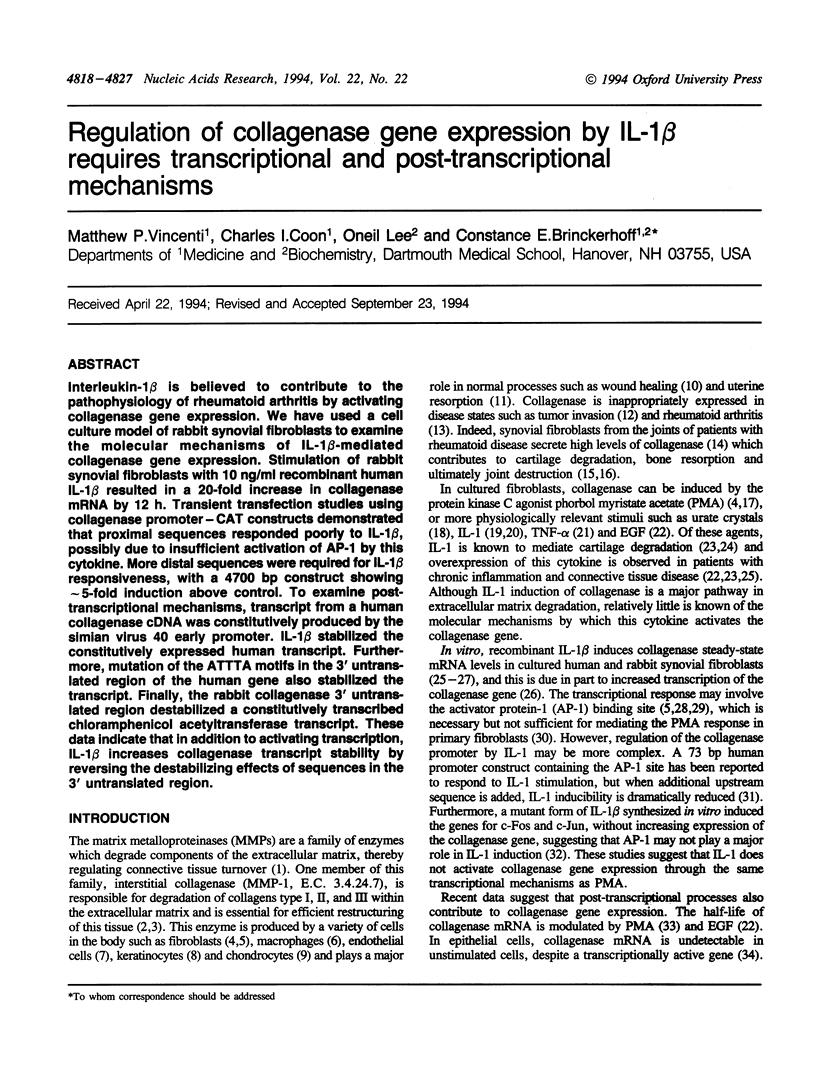
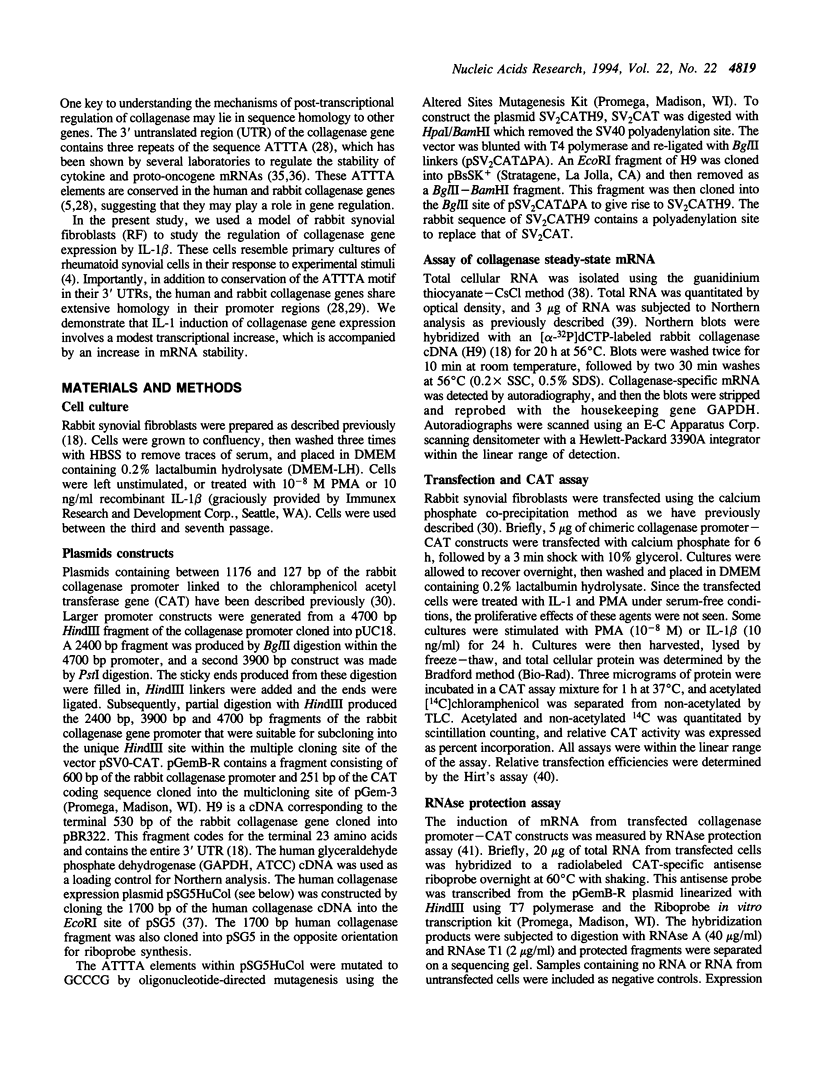
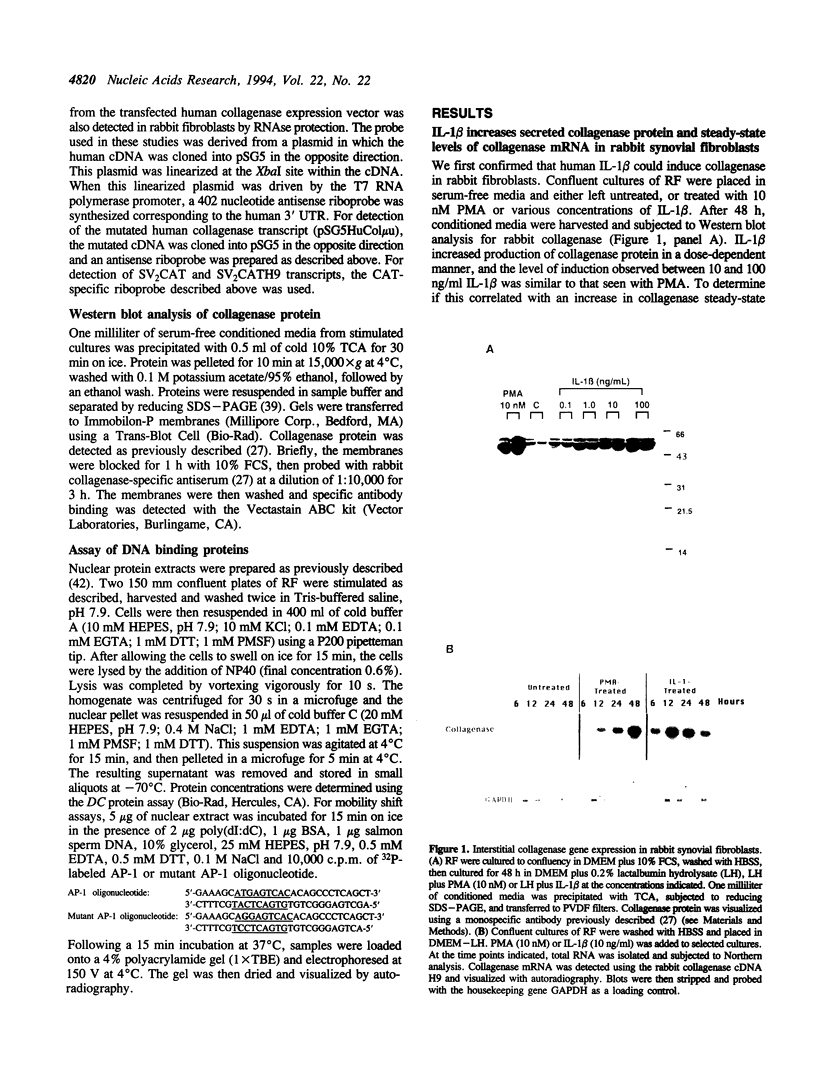
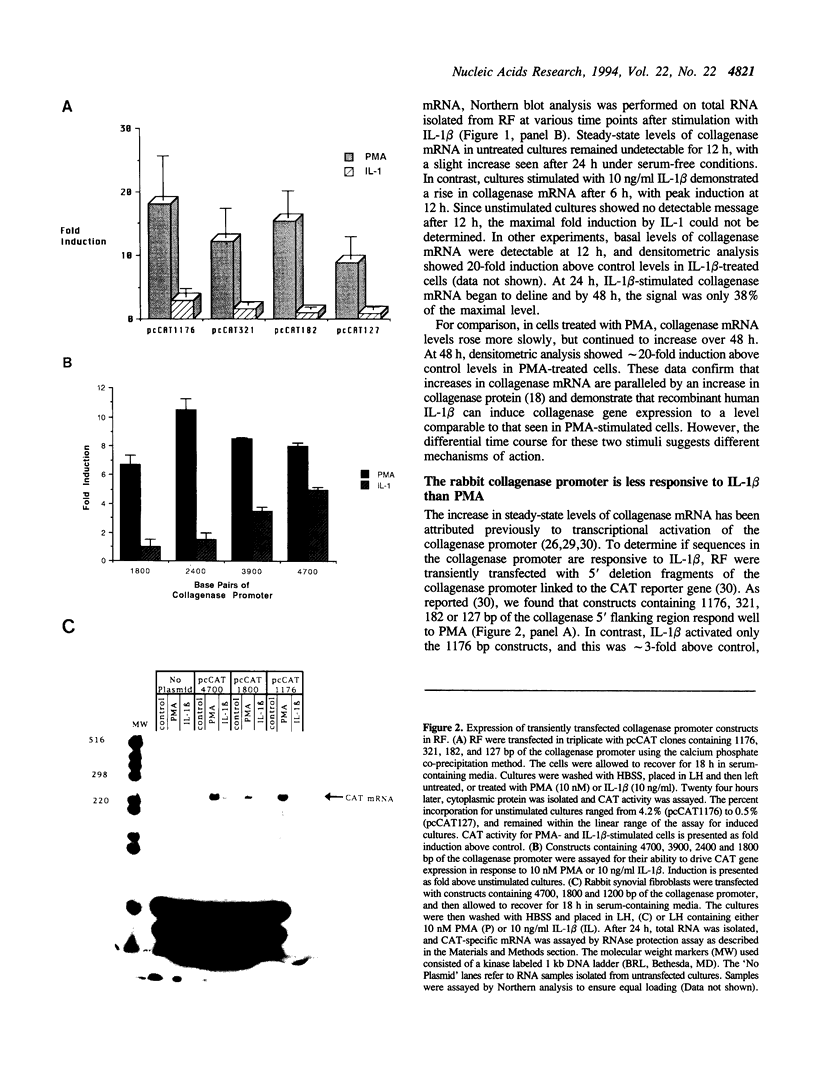
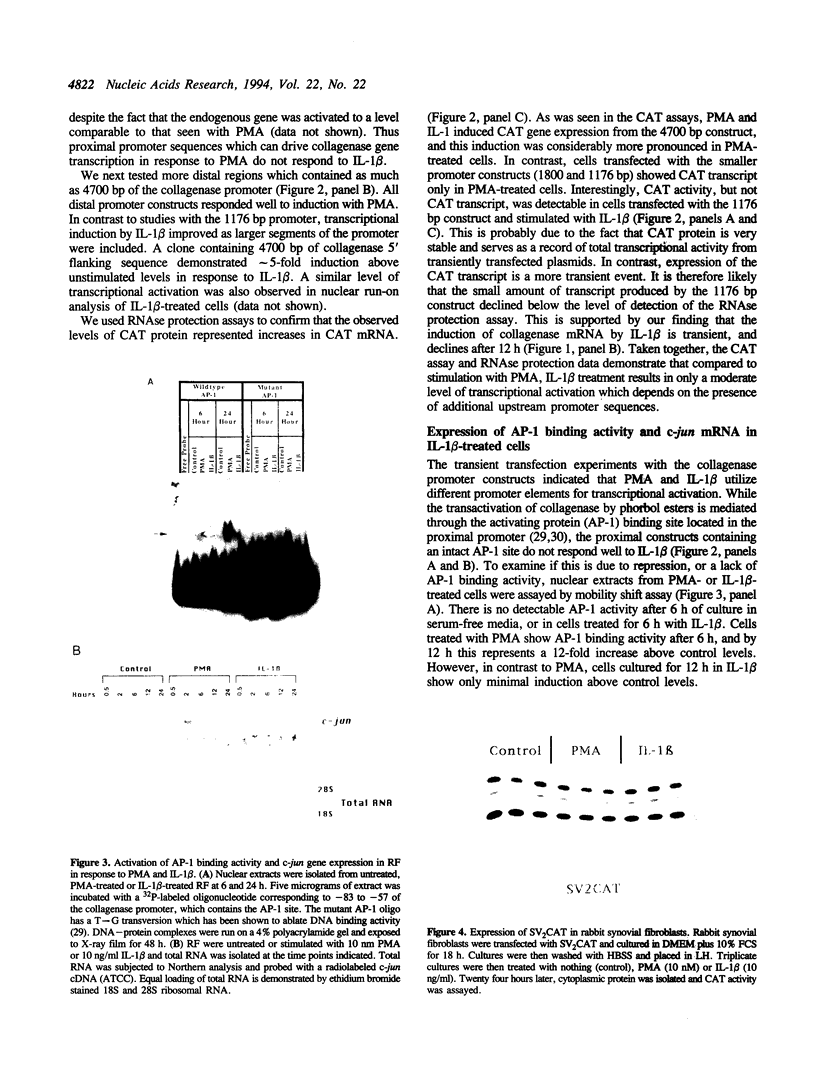
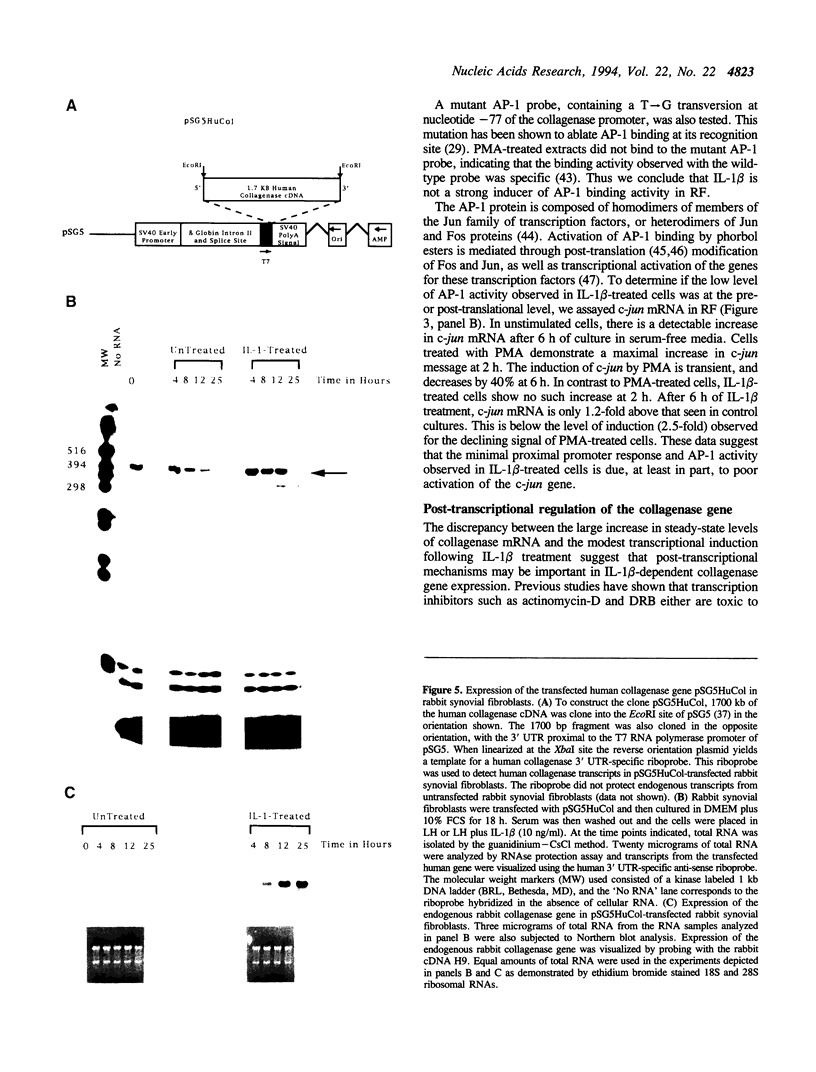
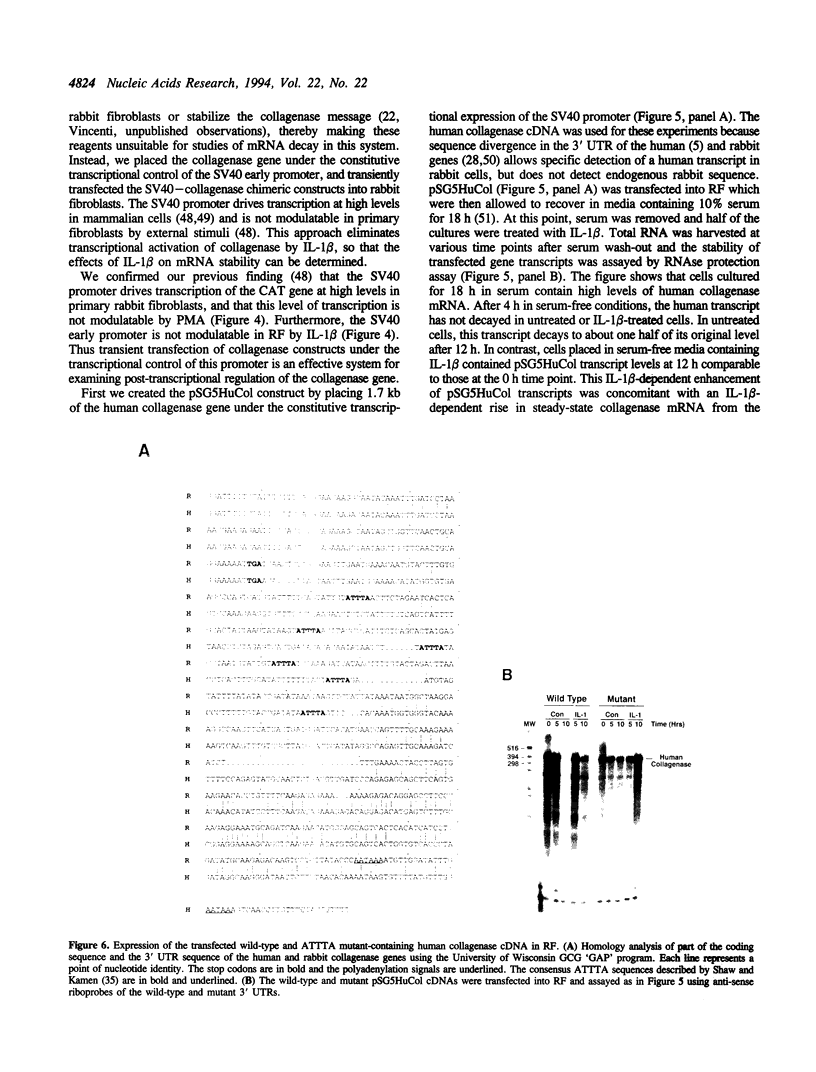
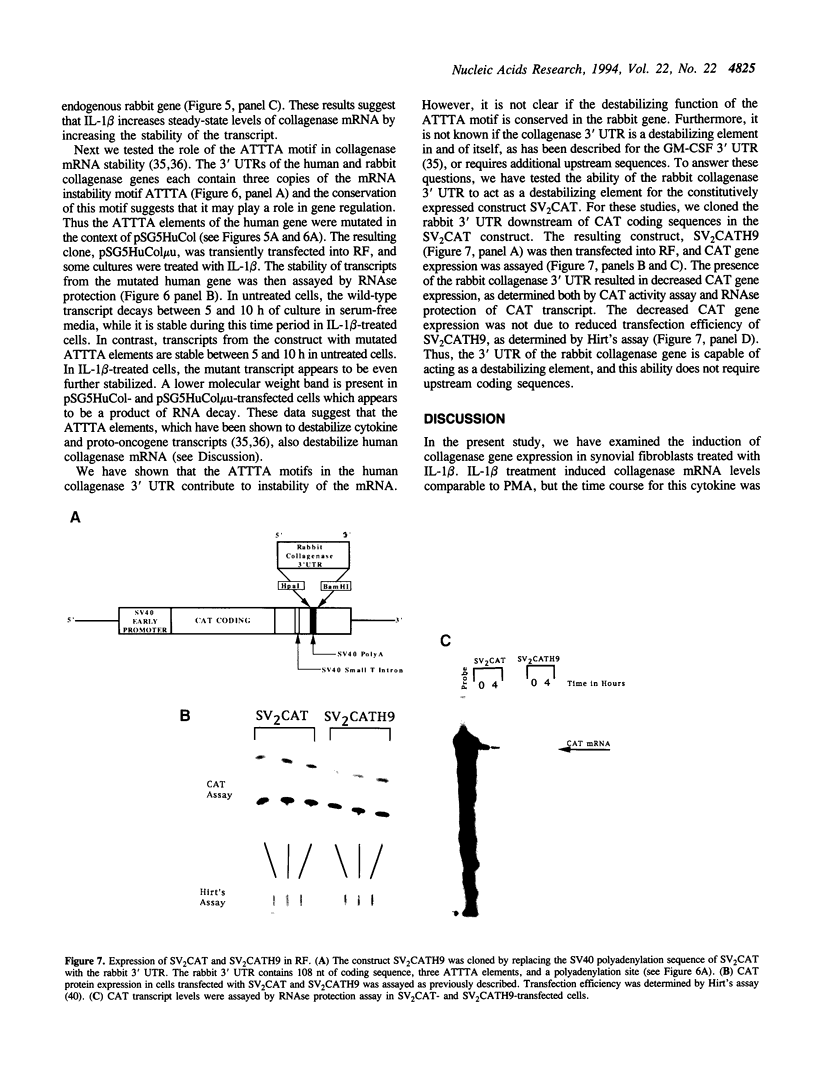
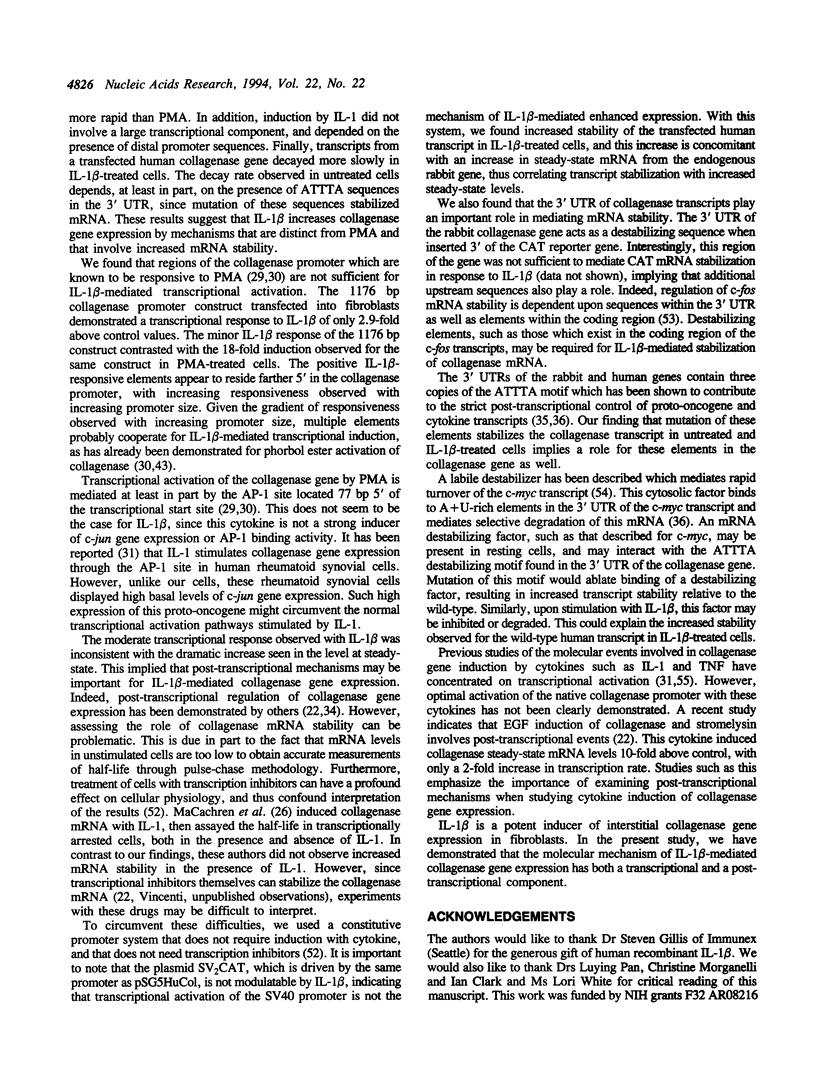
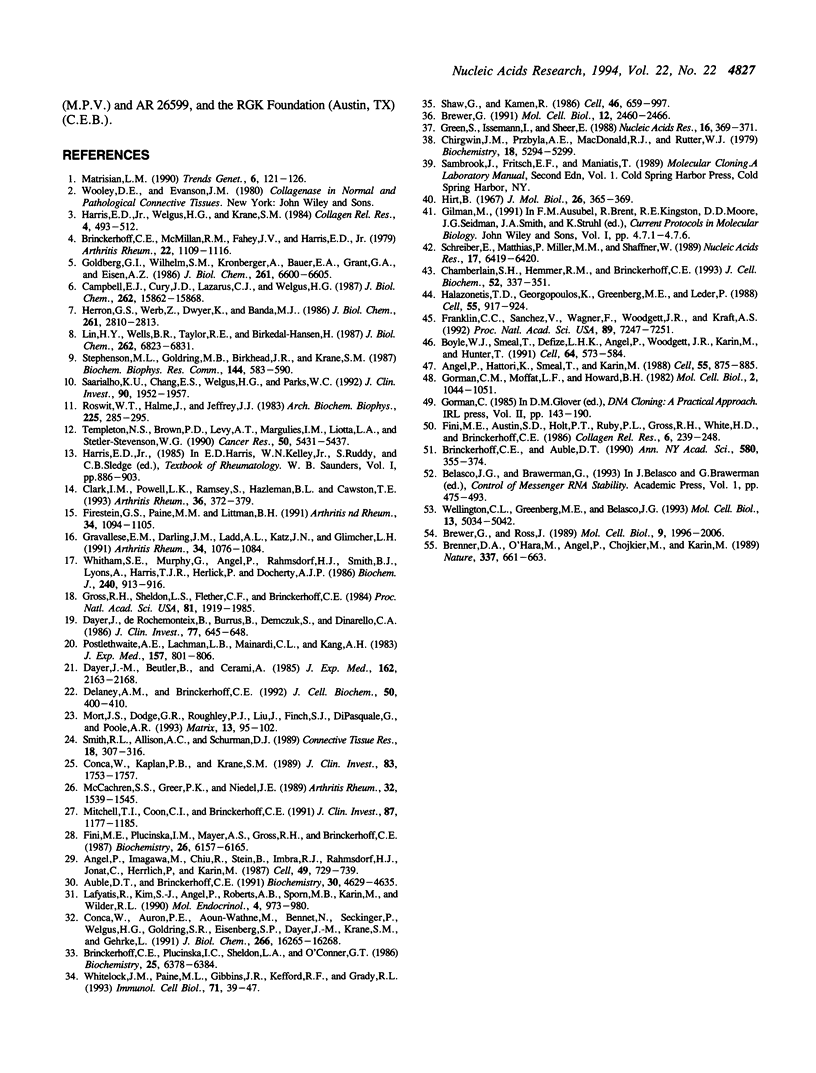
Images in this article
Selected References
These references are in PubMed. This may not be the complete list of references from this article.
- Angel P., Hattori K., Smeal T., Karin M. The jun proto-oncogene is positively autoregulated by its product, Jun/AP-1. Cell. 1988 Dec 2;55(5):875–885. doi: 10.1016/0092-8674(88)90143-2. [DOI] [PubMed] [Google Scholar]
- Angel P., Imagawa M., Chiu R., Stein B., Imbra R. J., Rahmsdorf H. J., Jonat C., Herrlich P., Karin M. Phorbol ester-inducible genes contain a common cis element recognized by a TPA-modulated trans-acting factor. Cell. 1987 Jun 19;49(6):729–739. doi: 10.1016/0092-8674(87)90611-8. [DOI] [PubMed] [Google Scholar]
- Auble D. T., Brinckerhoff C. E. The AP-1 sequence is necessary but not sufficient for phorbol induction of collagenase in fibroblasts. Biochemistry. 1991 May 7;30(18):4629–4635. doi: 10.1021/bi00232a039. [DOI] [PubMed] [Google Scholar]
- Boyle W. J., Smeal T., Defize L. H., Angel P., Woodgett J. R., Karin M., Hunter T. Activation of protein kinase C decreases phosphorylation of c-Jun at sites that negatively regulate its DNA-binding activity. Cell. 1991 Feb 8;64(3):573–584. doi: 10.1016/0092-8674(91)90241-p. [DOI] [PubMed] [Google Scholar]
- Brenner D. A., O'Hara M., Angel P., Chojkier M., Karin M. Prolonged activation of jun and collagenase genes by tumour necrosis factor-alpha. Nature. 1989 Feb 16;337(6208):661–663. doi: 10.1038/337661a0. [DOI] [PubMed] [Google Scholar]
- Brewer G. An A + U-rich element RNA-binding factor regulates c-myc mRNA stability in vitro. Mol Cell Biol. 1991 May;11(5):2460–2466. doi: 10.1128/mcb.11.5.2460. [DOI] [PMC free article] [PubMed] [Google Scholar]
- Brewer G., Ross J. Regulation of c-myc mRNA stability in vitro by a labile destabilizer with an essential nucleic acid component. Mol Cell Biol. 1989 May;9(5):1996–2006. doi: 10.1128/mcb.9.5.1996. [DOI] [PMC free article] [PubMed] [Google Scholar]
- Brinckerhoff C. E., Auble D. T. Regulation of collagenase gene expression in synovial fibroblasts. Ann N Y Acad Sci. 1990;580:355–374. doi: 10.1111/j.1749-6632.1990.tb17944.x. [DOI] [PubMed] [Google Scholar]
- Brinckerhoff C. E., McMillan R. M., Fahey J. V., Harris E. D., Jr Collagenase production by synovial fibroblasts treated with phorbol myristate acetate. Arthritis Rheum. 1979 Oct;22(10):1109–1116. doi: 10.1002/art.1780221010. [DOI] [PubMed] [Google Scholar]
- Brinckerhoff C. E., Plucinska I. M., Sheldon L. A., O'Connor G. T. Half-life of synovial cell collagenase mRNA is modulated by phorbol myristate acetate but not by all-trans-retinoic acid or dexamethasone. Biochemistry. 1986 Oct 21;25(21):6378–6384. doi: 10.1021/bi00369a006. [DOI] [PubMed] [Google Scholar]
- Campbell E. J., Cury J. D., Lazarus C. J., Welgus H. G. Monocyte procollagenase and tissue inhibitor of metalloproteinases. Identification, characterization, and regulation of secretion. J Biol Chem. 1987 Nov 25;262(33):15862–15868. [PubMed] [Google Scholar]
- Chamberlain S. H., Hemmer R. M., Brinckerhoff C. E. Novel phorbol ester response region in the collagenase promoter binds Fos and Jun. J Cell Biochem. 1993 Jul;52(3):337–351. doi: 10.1002/jcb.240520310. [DOI] [PubMed] [Google Scholar]
- Chirgwin J. M., Przybyla A. E., MacDonald R. J., Rutter W. J. Isolation of biologically active ribonucleic acid from sources enriched in ribonuclease. Biochemistry. 1979 Nov 27;18(24):5294–5299. doi: 10.1021/bi00591a005. [DOI] [PubMed] [Google Scholar]
- Clark I. M., Powell L. K., Ramsey S., Hazleman B. L., Cawston T. E. The measurement of collagenase, tissue inhibitor of metalloproteinases (TIMP), and collagenase-TIMP complex in synovial fluids from patients with osteoarthritis and rheumatoid arthritis. Arthritis Rheum. 1993 Mar;36(3):372–379. doi: 10.1002/art.1780360313. [DOI] [PubMed] [Google Scholar]
- Conca W., Auron P. E., Aoun-Wathne M., Bennett N., Seckinger P., Welgus H. G., Goldring S. R., Eisenberg S. P., Dayer J. M., Krane S. M. An interleukin 1 beta point mutant demonstrates that jun/fos expression is not sufficient for fibroblast metalloproteinase expression. J Biol Chem. 1991 Sep 5;266(25):16265–16268. [PubMed] [Google Scholar]
- Conca W., Kaplan P. B., Krane S. M. Increases in levels of procollagenase messenger RNA in cultured fibroblasts induced by human recombinant interleukin 1 beta or serum follow c-jun expression and are dependent on new protein synthesis. J Clin Invest. 1989 May;83(5):1753–1757. doi: 10.1172/JCI114077. [DOI] [PMC free article] [PubMed] [Google Scholar]
- Dayer J. M., Beutler B., Cerami A. Cachectin/tumor necrosis factor stimulates collagenase and prostaglandin E2 production by human synovial cells and dermal fibroblasts. J Exp Med. 1985 Dec 1;162(6):2163–2168. doi: 10.1084/jem.162.6.2163. [DOI] [PMC free article] [PubMed] [Google Scholar]
- Dayer J. M., de Rochemonteix B., Burrus B., Demczuk S., Dinarello C. A. Human recombinant interleukin 1 stimulates collagenase and prostaglandin E2 production by human synovial cells. J Clin Invest. 1986 Feb;77(2):645–648. doi: 10.1172/JCI112350. [DOI] [PMC free article] [PubMed] [Google Scholar]
- Delany A. M., Brinckerhoff C. E. Post-transcriptional regulation of collagenase and stromelysin gene expression by epidermal growth factor and dexamethasone in cultured human fibroblasts. J Cell Biochem. 1992 Dec;50(4):400–410. doi: 10.1002/jcb.240500409. [DOI] [PubMed] [Google Scholar]
- Fini M. E., Austin S. D., Holt P. T., Ruby P. L., Gross R. H., White H. D., Brinckerhoff C. E. Homology between exon-containing portions of rabbit genomic clones for synovial cell collagenase and human foreskin and synovial cell mRNAs. Coll Relat Res. 1986 Jul;6(3):239–248. doi: 10.1016/s0174-173x(86)80009-7. [DOI] [PubMed] [Google Scholar]
- Fini M. E., Plucinska I. M., Mayer A. S., Gross R. H., Brinckerhoff C. E. A gene for rabbit synovial cell collagenase: member of a family of metalloproteinases that degrade the connective tissue matrix. Biochemistry. 1987 Sep 22;26(19):6156–6165. doi: 10.1021/bi00393a032. [DOI] [PubMed] [Google Scholar]
- Firestein G. S., Paine M. M., Littman B. H. Gene expression (collagenase, tissue inhibitor of metalloproteinases, complement, and HLA-DR) in rheumatoid arthritis and osteoarthritis synovium. Quantitative analysis and effect of intraarticular corticosteroids. Arthritis Rheum. 1991 Sep;34(9):1094–1105. doi: 10.1002/art.1780340905. [DOI] [PubMed] [Google Scholar]
- Franklin C. C., Sanchez V., Wagner F., Woodgett J. R., Kraft A. S. Phorbol ester-induced amino-terminal phosphorylation of human JUN but not JUNB regulates transcriptional activation. Proc Natl Acad Sci U S A. 1992 Aug 1;89(15):7247–7251. doi: 10.1073/pnas.89.15.7247. [DOI] [PMC free article] [PubMed] [Google Scholar]
- Goldberg G. I., Wilhelm S. M., Kronberger A., Bauer E. A., Grant G. A., Eisen A. Z. Human fibroblast collagenase. Complete primary structure and homology to an oncogene transformation-induced rat protein. J Biol Chem. 1986 May 15;261(14):6600–6605. [PubMed] [Google Scholar]
- Gorman C. M., Moffat L. F., Howard B. H. Recombinant genomes which express chloramphenicol acetyltransferase in mammalian cells. Mol Cell Biol. 1982 Sep;2(9):1044–1051. doi: 10.1128/mcb.2.9.1044. [DOI] [PMC free article] [PubMed] [Google Scholar]
- Gravallese E. M., Darling J. M., Ladd A. L., Katz J. N., Glimcher L. H. In situ hybridization studies of stromelysin and collagenase messenger RNA expression in rheumatoid synovium. Arthritis Rheum. 1991 Sep;34(9):1076–1084. doi: 10.1002/art.1780340903. [DOI] [PubMed] [Google Scholar]
- Green S., Issemann I., Sheer E. A versatile in vivo and in vitro eukaryotic expression vector for protein engineering. Nucleic Acids Res. 1988 Jan 11;16(1):369–369. doi: 10.1093/nar/16.1.369. [DOI] [PMC free article] [PubMed] [Google Scholar]
- Gross R. H., Sheldon L. A., Fletcher C. F., Brinckerhoff C. E. Isolation of a collagenase cDNA clone and measurement of changing collagenase mRNA levels during induction in rabbit synovial fibroblasts. Proc Natl Acad Sci U S A. 1984 Apr;81(7):1981–1985. doi: 10.1073/pnas.81.7.1981. [DOI] [PMC free article] [PubMed] [Google Scholar]
- Halazonetis T. D., Georgopoulos K., Greenberg M. E., Leder P. c-Jun dimerizes with itself and with c-Fos, forming complexes of different DNA binding affinities. Cell. 1988 Dec 2;55(5):917–924. doi: 10.1016/0092-8674(88)90147-x. [DOI] [PubMed] [Google Scholar]
- Harris E. D., Jr, Welgus H. G., Krane S. M. Regulation of the mammalian collagenases. Coll Relat Res. 1984 Dec;4(6):493–512. doi: 10.1016/s0174-173x(84)80015-1. [DOI] [PubMed] [Google Scholar]
- Herron G. S., Werb Z., Dwyer K., Banda M. J. Secretion of metalloproteinases by stimulated capillary endothelial cells. I. Production of procollagenase and prostromelysin exceeds expression of proteolytic activity. J Biol Chem. 1986 Feb 25;261(6):2810–2813. [PubMed] [Google Scholar]
- Hirt B. Selective extraction of polyoma DNA from infected mouse cell cultures. J Mol Biol. 1967 Jun 14;26(2):365–369. doi: 10.1016/0022-2836(67)90307-5. [DOI] [PubMed] [Google Scholar]
- Lafyatis R., Kim S. J., Angel P., Roberts A. B., Sporn M. B., Karin M., Wilder R. L. Interleukin-1 stimulates and all-trans-retinoic acid inhibits collagenase gene expression through its 5' activator protein-1-binding site. Mol Endocrinol. 1990 Jul;4(7):973–980. doi: 10.1210/mend-4-7-973. [DOI] [PubMed] [Google Scholar]
- Lin H. Y., Wells B. R., Taylor R. E., Birkedal-Hansen H. Degradation of type I collagen by rat mucosal keratinocytes. Evidence for secretion of a specific epithelial collagenase. J Biol Chem. 1987 May 15;262(14):6823–6831. [PubMed] [Google Scholar]
- Matrisian L. M. Metalloproteinases and their inhibitors in matrix remodeling. Trends Genet. 1990 Apr;6(4):121–125. doi: 10.1016/0168-9525(90)90126-q. [DOI] [PubMed] [Google Scholar]
- McCachren S. S., Greer P. K., Niedel J. E. Regulation of human synovial fibroblast collagenase messenger RNA by interleukin-1. Arthritis Rheum. 1989 Dec;32(12):1539–1545. doi: 10.1002/anr.1780321207. [DOI] [PubMed] [Google Scholar]
- Mitchell T. I., Coon C. I., Brinckerhoff C. E. Serum amyloid A (SAA3) produced by rabbit synovial fibroblasts treated with phorbol esters or interleukin 1 induces synthesis of collagenase and is neutralized with specific antiserum. J Clin Invest. 1991 Apr;87(4):1177–1185. doi: 10.1172/JCI115116. [DOI] [PMC free article] [PubMed] [Google Scholar]
- Mort J. S., Dodge G. R., Roughley P. J., Liu J., Finch S. J., DiPasquale G., Poole A. R. Direct evidence for active metalloproteinases mediating matrix degradation in interleukin 1-stimulated human articular cartilage. Matrix. 1993 Mar;13(2):95–102. doi: 10.1016/s0934-8832(11)80068-5. [DOI] [PubMed] [Google Scholar]
- Müller M. M., Schreiber E., Schaffner W., Matthias P. Rapid test for in vivo stability and DNA binding of mutated octamer binding proteins with 'mini-extracts' prepared from transfected cells. Nucleic Acids Res. 1989 Aug 11;17(15):6420–6420. doi: 10.1093/nar/17.15.6420. [DOI] [PMC free article] [PubMed] [Google Scholar]
- Postlethwaite A. E., Lachman L. B., Mainardi C. L., Kang A. H. Interleukin 1 stimulation of collagenase production by cultured fibroblasts. J Exp Med. 1983 Feb 1;157(2):801–806. doi: 10.1084/jem.157.2.801. [DOI] [PMC free article] [PubMed] [Google Scholar]
- Roswit W. T., Halme J., Jeffrey J. J. Purification and properties of rat uterine procollagenase. Arch Biochem Biophys. 1983 Aug;225(1):285–295. doi: 10.1016/0003-9861(83)90032-2. [DOI] [PubMed] [Google Scholar]
- Saarialho-Kere U. K., Chang E. S., Welgus H. G., Parks W. C. Distinct localization of collagenase and tissue inhibitor of metalloproteinases expression in wound healing associated with ulcerative pyogenic granuloma. J Clin Invest. 1992 Nov;90(5):1952–1957. doi: 10.1172/JCI116073. [DOI] [PMC free article] [PubMed] [Google Scholar]
- Shaw G., Kamen R. A conserved AU sequence from the 3' untranslated region of GM-CSF mRNA mediates selective mRNA degradation. Cell. 1986 Aug 29;46(5):659–667. doi: 10.1016/0092-8674(86)90341-7. [DOI] [PubMed] [Google Scholar]
- Smith R. L., Allison A. C., Schurman D. J. Induction of articular cartilage degradation by recombinant interleukin 1 alpha and 1 beta. Connect Tissue Res. 1989;18(4):307–316. doi: 10.3109/03008208909019079. [DOI] [PubMed] [Google Scholar]
- Stephenson M. L., Goldring M. B., Birkhead J. R., Krane S. M., Rahmsdorf H. J., Angel P. Stimulation of procollagenase synthesis parallels increases in cellular procollagenase mRNA in human articular chondrocytes exposed to recombinant interleukin 1 beta or phorbol ester. Biochem Biophys Res Commun. 1987 Apr 29;144(2):583–590. doi: 10.1016/s0006-291x(87)80006-2. [DOI] [PubMed] [Google Scholar]
- Templeton N. S., Brown P. D., Levy A. T., Margulies I. M., Liotta L. A., Stetler-Stevenson W. G. Cloning and characterization of human tumor cell interstitial collagenase. Cancer Res. 1990 Sep 1;50(17):5431–5437. [PubMed] [Google Scholar]
- Wellington C. L., Greenberg M. E., Belasco J. G. The destabilizing elements in the coding region of c-fos mRNA are recognized as RNA. Mol Cell Biol. 1993 Aug;13(8):5034–5042. doi: 10.1128/mcb.13.8.5034. [DOI] [PMC free article] [PubMed] [Google Scholar]
- Whitelock J. M., Paine M. L., Gibbins J. R., Kefford R. F., O'Grady R. L. Multiple levels of post-transcriptional regulation of collagenase (matrix metalloproteinase 1) in an epithelial cell line. Immunol Cell Biol. 1993 Feb;71(Pt 1):39–47. doi: 10.1038/icb.1993.4. [DOI] [PubMed] [Google Scholar]
- Whitham S. E., Murphy G., Angel P., Rahmsdorf H. J., Smith B. J., Lyons A., Harris T. J., Reynolds J. J., Herrlich P., Docherty A. J. Comparison of human stromelysin and collagenase by cloning and sequence analysis. Biochem J. 1986 Dec 15;240(3):913–916. doi: 10.1042/bj2400913. [DOI] [PMC free article] [PubMed] [Google Scholar]



